PAGE 84 – April 2009
H O T I D E A S F O R S M A L L R A I L R O A D S
 The classic small-or-micro layout is a straight board about the size of a bookshelf. This collection of shelf layouts in HO or smaller is Part 2… Part 1 appeared here.
The classic small-or-micro layout is a straight board about the size of a bookshelf. This collection of shelf layouts in HO or smaller is Part 2… Part 1 appeared here.
In This Issue
Krohnkoppel—HO narrow-gauge line in a small room
Classic Switchers—Inglenook and Timesaver, shown side by side
Tiny Railway—A little N workshop from Wales
Cisco, Utah—HO scene built for photography
SLT: Garden Railway—Following a large-scale prototype
SLT: St. Jude—Busy terminus of an English branch line
X Yard—Low-cost switching challenge yard
North Leigh—Classic British branch line terminus made in NZ
N Loco Terminal—With a turntable made from a CD
N Shelf & Module—Scenic shelf and engine terminal module
Porterhouse Sidings—EM gauge Inglenook switching shelf
The Winstondale Switcher—Extremely narrow N switching district
Station Renez—HOm model of Swiss mountain resort station
NARROW GAUGE IN THE LUMBER ROOM — A SMALL GEM
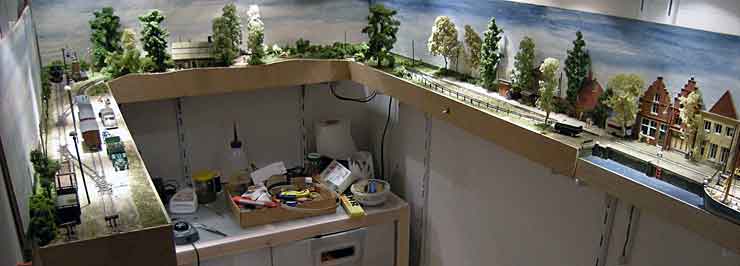
Thorsten Marx, from Hamburg, Germany, lives in a single-room flat and could find layout space only in a small lumber room measuring 140x90cm (55x35in). So he built Krohnkoppel-Brook, an H0e branch line (1:87 scale on 9mm gauge), as a walk-in shelf line!
The line runs from the small, inland town of Krohnkoppel (at the left), around the U to the station and port facilities at Brook (on the right side). Follow along as a locomotive emerges from the engine facilities and picks up two freight cars at Krohnkoppel (upper left photo, below), adds a coach of passengers, and trundles through the north German countryside to the passing siding at Brook (upper right, below). The little loco drops the coach at the platform by the loop, runs around the freight wagons (lower left, below), pulls them back onto the main and then shoves them into the port track at Brook (lower right, below).
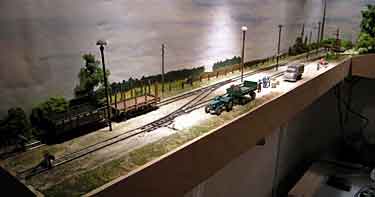
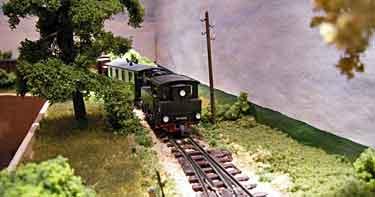
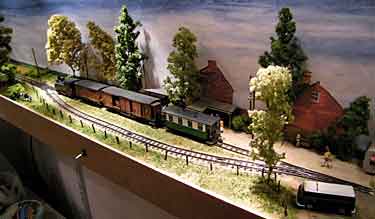
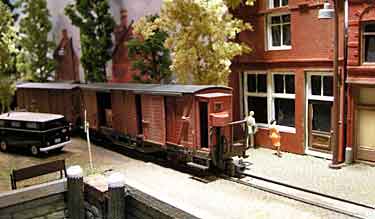
We have time for a short walk around the Brook port (below) while the engineer enjoys a cappuccino break and the fireman gets himself a fish roll. The photos below show some of the mini-scenes on this most photogenic part of the line. There are many more photos of this attractive layout at Thorsten’s German-only website. (As always, you can order up a translation of any site by entering its address at Google Language Tools or Yahoo! Babelfish.)
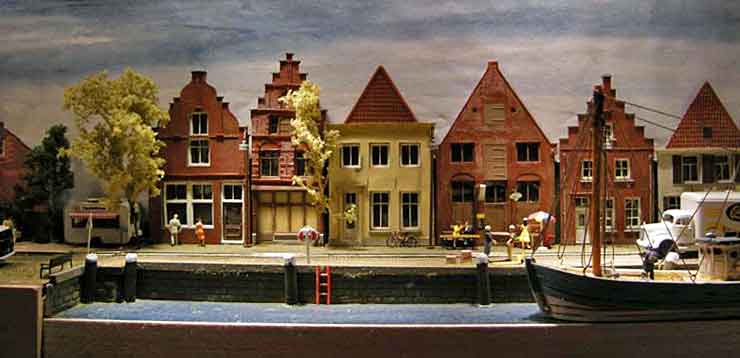
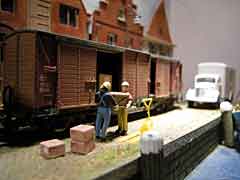
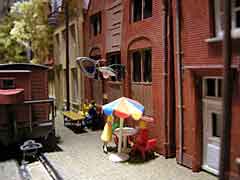
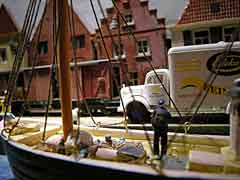
CLASSIC SHUNTING LAYOUTS HIGHLIGHT PITTSBURGH NMRA MEET
In an unusual juxtaposition, the two classic switching-game layouts—an Inglenook and a Timesaver—were featured side by side at the recent Pittsburgh Jamboree sponsored by NMRA Mid-Central Region’s Division 2 and held in Moon Township, Pennsylvania, USA. The Inglenook design, invented by Alan Wright, is the most popular switching puzzle and game in Britain. The example shown here (left below) is under construction by Bill Sartore, from suburban Pittsburgh. The Timesaver, introduced by John Allen, is the USA’s most often used switching game. This example (right below), called Dante, is being built by Ray Persing, from Tipp City, Ohio USA. For excellent descriptions of both Inglenook and Timesaver designs and operation, see Adrian Wymann’s excellent Shunting Puzzles website.
Photos by Carl Arendt
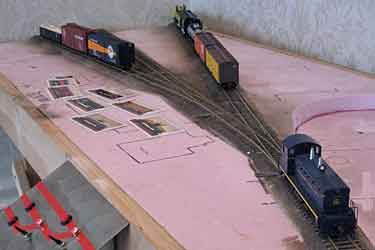
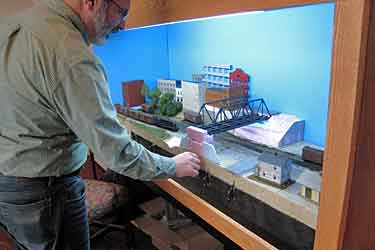
N SCALE RAILWAY WORKSHOP… SMALLER THAN A SHOEBOX!
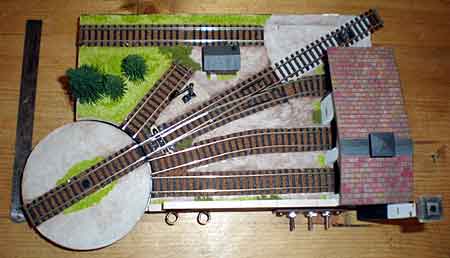
Chris Bayley, from Prestatyn, North Wales UK, originally planned this tiny N-scale layout as an entry in the “World’s Smallest Working Model Railroad” challenge held last year on this site. Because it was clear that the 8½x5¾in design was too large for that competition, I asked Chris if I might feature it in a Scrapbook page, because I feel it offers an amazing amount of operating fun in a very tiny space. Chris graciously agreed.
When not in use, the sector plate and turntable top are removable. Note that the ruler in the photos is six inches long. Chris explains, “The layout represents a small carriage and wagon workshop somewhere in Germany. Operation consists of making up a train of three vehicles behind the train engine, selected from five vehicles (three long and two short) in the works sidings. Then the vehicles, magically converted to an arriving train, are redistributed back on these sidings. There are three steam locomotives in operation—the train engine and two yard engines which work in turns. It’s an enjoyable layout to operate, but one needs good eyesight (or glasses) and a steady hand as coupling and uncoupling are done manually.” And all this is accomplished in an area the size of half a sheet of letter paper!
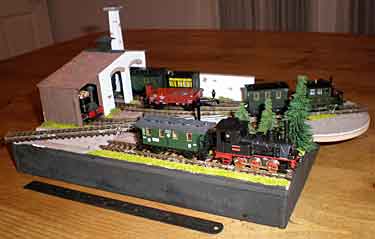
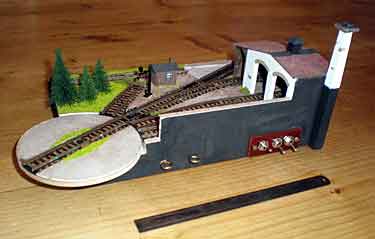
SCENIC HO LAYOUT WAS DESIGNED FOR PHOTOGRAPHY
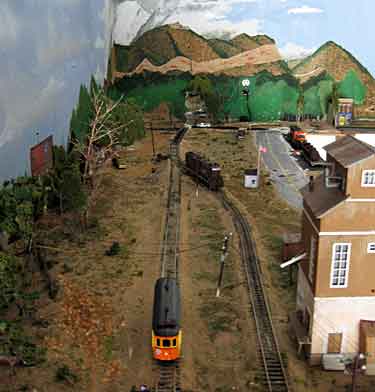
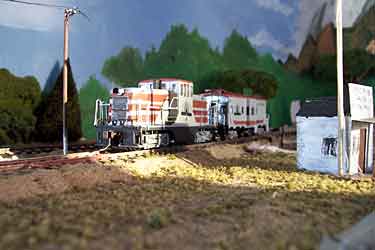
Not every small layout is designed with maximum trackage for operation. Joshua Bernhard, from Farr West, Utah USA, designed Cisco with wide scenic margins to allow good photographic opportunities. Cisco is 5ft (150cm) long and has one siding. The tiny Post Office is a model of the real one at Cisco, Utah.
VISIT A PAIR OF SLTs — SINGLE LINE TERMINI
SLTs (Single Line Termini) have been receiving a good bit of attention lately, both on this site and in several modeling fora. Small wonder—they’re prototypically correct dead-end spurs that are operated regularly as End-of-the-Line termini. There are lots of examples of prototype SLTs available, in both Britain and the US, in both passenger and freight service. Here are two layouts that take advantage of this opportunity to model real-world operations in a very slim space.


Combining two unusual prototypes results in this shoebox sized OO railway, called 10 New Forest Way and submitted by ‘Anonymous in Britain’ who built it over a one-week half term school holiday. The shy builder combined the trackplan of a nearby 7¼in-gauge garden line, Wenyon Estate Railway (lower right), with a standard gauge hobby line in Britain that hauls a brake van through a (large) backyard. This model layout runs from a small platform on the right, around the bend, to the EOT at the left. The scenery is designed to provide some talking points whilst the train goes back and forth. According to Anon, “The main point of the layout is to start a conversation on the subject and to keep me occupied during that half term.”


Photos by Andrew Smith
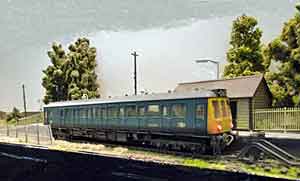
At the other end of the spectrum, Stu Davies, from Broadstairs, Kent UK, has an OO model of an SLT in regular railway service. He explains, “Set in the latter half of the 60’s, St. Jude represents a branch line now reduced to a long siding worked on the ‘single engine in steam’ principle, sans points, signals and practically everything else. A suprising number survived, and the idea first occurred when I saw Sheringham station in Norfolk a number of years ago. The size of board was dictated by the biggest I could get in the back of the car in one piece, 64in long by 6in wide. There’s also a small 20in fiddle yard with a couple of sidings.”
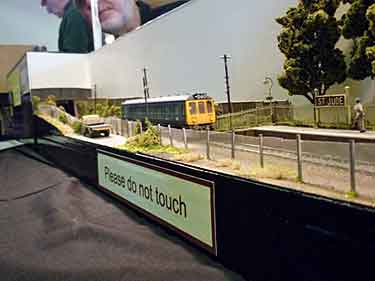
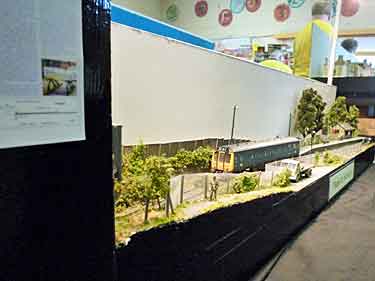
‘X YARD’ BOOSTS OPERATIONS WITH MINIMUM TURNOUTS


X Yard drawn to scale, 60x12in (180x30cm).
Stephen A. Ralls, from McLean, Virginia USA, designed X Yard to provide reasonably good operation with small size and few turnouts. A variation on Chris Ellis’s Small Street Yard/Kleinhof, this line makes excellent use of the space with just a double-slip switch and one standard turnout. Stephen added, “The use of the traverser as a runaround was inspired by the tipple feature on Carl’s Exports. The traverser can also serve as a small fiddle yard where cars can be introduced or removed.” Stephen left dimensions open, depending on scale; a quick scale drawing (right) using RailModeller software demonstrates that X Yard will squeeze comfortably into a 5x1ft (150x30cm) shelf in HO, though a six-foot length would allow more relaxed trackwork. Stephen points out that the three tracks to the left of the plan can also be used as an Inglenook switching game.
OO LINE EXUDES BRANCH LINE ATMOSPHERE
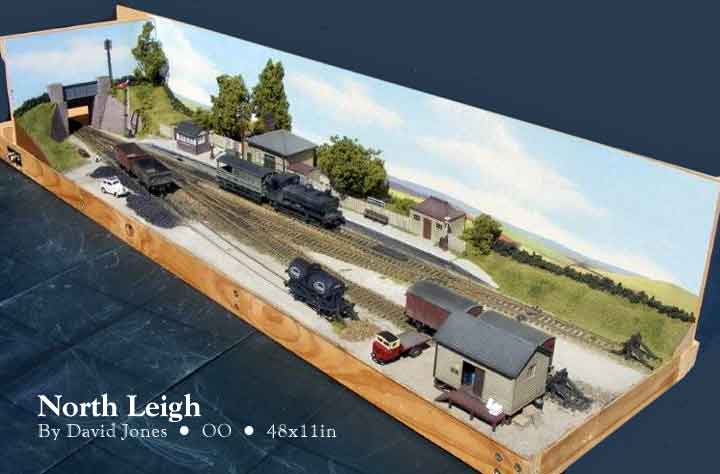
David Jones, from Tauranga, New Zealand, has built a classic branch-line layout in 48x11in (120x28cm), with a removable 24×3½in (60x9cm) fiddle yard extension. David explains, “North Leigh represents a small terminus set in Oxfordshire, England in the late 1950s. There is a run-round loop that will take three wagons and a brake van [caboose], or a single coach and van. I have tried to create a sense of spaciousness and retain operational interest by creating a long ‘back siding’ off the entrance to the fiddle yard. You have to imagine that the loco servicing facilities are the other side of the bridge.”
Buildings are a mixture of kit and scratchbuilt, with prototypes based on the ex-GWR Fairford Branch Line. The inspiration for North Leigh came from Martin Loader’s excellent website of the Fairford line. “The micro-layout concept,” comments David, “has proven a good one for me in trying out new techniques and actually finishing something!”
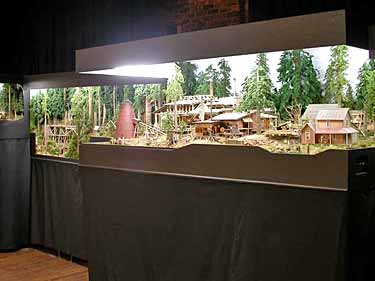
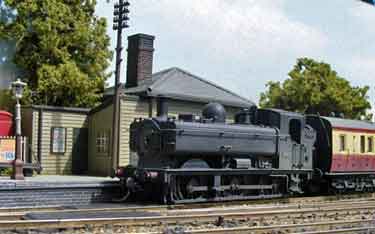
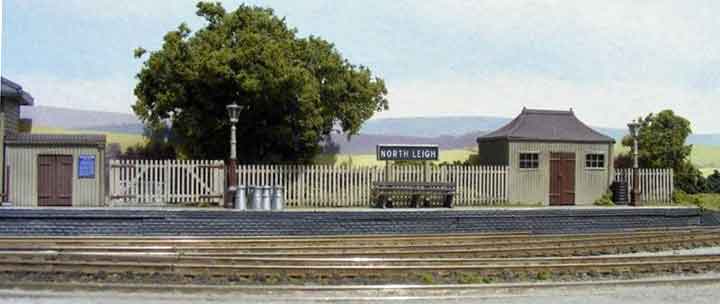
N SHELF USES TURNTABLE MADE FROM A CD
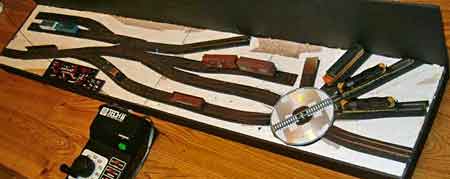
Anthony Kochevar, from in South Jordan, Utah USA, is building this 48x9in (120x23cm) N-scale switching line. It splits in the middle, dividing into two parts to fit in a suitcase for travel. Large rare-earth magnets are used to hold the two sections together. The turntable is made from a CD and its jewel case (see below), as explained in an article on this site.
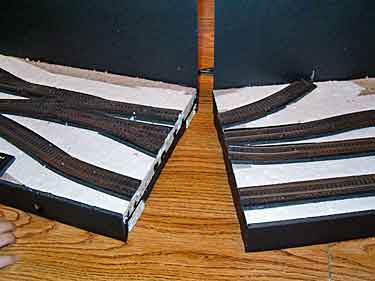
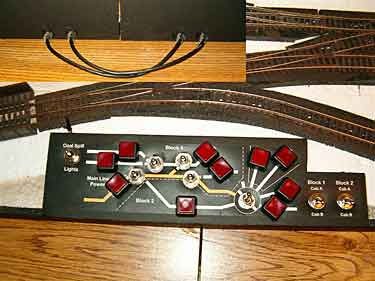
“The best thing I discovered on the site was the CD turntable article,” Anthony declares. “I thought I could not have a turntable due to the size. [But] a CD is perfect for a standard N scale loco to fit on.” The photos below illustrate Anthony’s method for powering the table, which is different from the technique shown in the original article.
“For about $7 USD I powered it using a 1/8in stereo headphone plug and jack. The only downside is you must have one inch of space (2.5cm) available directly under the center of the turntable to house the phone jack.” Radio Shack parts that Anthony used: 1/8in Stereo Phone Jack, #274-0246; 1.8in Stereo Phone Plug, #274-0284. Unscrew the plug from the plastic shell and remove the large outer ground solder pole.



SCENIC N SHELF WILL CONNECT WITH TURNTABLE MODULE
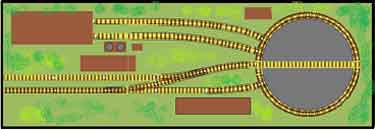
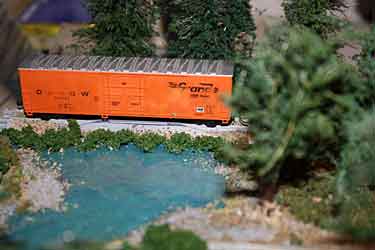
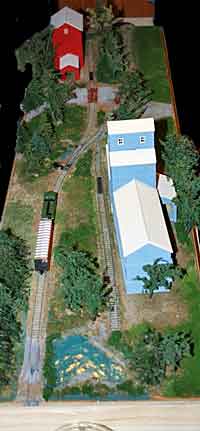
Another approach to an N-scale turntable switching module is illustrated by this design (right) from Ed Maciulis, who lives in Hamilton, Ontario Canada. It measures 24x12in (60x30cm) and will eventually be connected with a shelf line that Ed is constructing.
As we were preparing to publish this page, Ed sent photos of the shelf-switcher he’s working on, and a very attractive layout it is (left and right)! Measuring 4x1ft (120x30cm), the line uses the time-honored “Two Turnout Theme,” which provides both good operation and excellent scenic possibiities. Ed took advantage of this opportunity and scratchbuilt all the structures and trees. He made the water from blue plastic sheet material. The turntable module, when completed, will attach to the track in the foreground.
CLASSIC INGLENOOK PLAN FITS NICELY ON SHELF IN OO SCALE
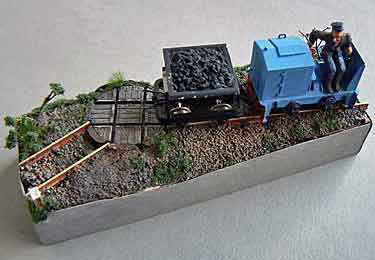
Tim Halket, from Suffolk, England, calls his OO version of the Inglenook design, Porterhouse Sidings. He uses it as a test bed for scenery construction techniques (and has ripped out several versions in the process). Current version is shown.
“I left the headshunt longer [than usual] so that I could use some big diesels (class 37 and 47) for shunting,” says Tim. “Typically, my seven year old son has reinvented the game; he simply tries to make the longest train possible!”
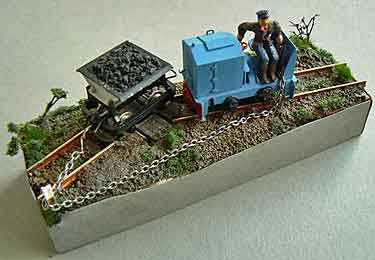
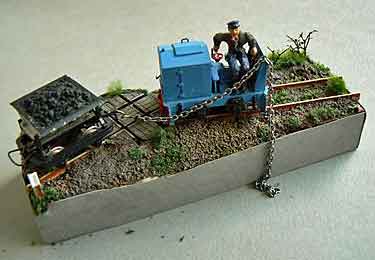
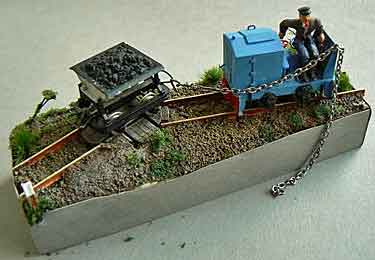
NARROW N SHELF ALLOWS OPERATION IN VIRTUALLY NO SPACE

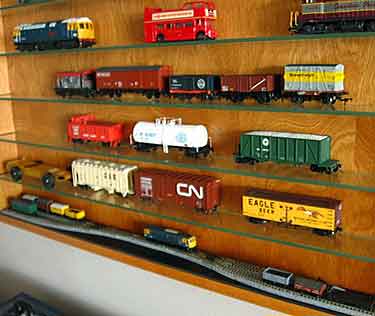
Because he had a small collection of British N-scale rolling stock, Michael-John Idzerda, from London, Ontario Canada, needed a layout on which to run them. He designed and is building The Winstondale Switcher, a 36×2½in (90x6cm) shelf line that proves anyone has room for a model railroad!
MJ explicates, “The purpose is to switch cars to and from two industries: the fictitious Winstondale Confectionery Factory and the Victory Tie Co. The fiddlin’ is done on the yard lead and will be landscaped with trees to separate the rural from the industrial.” The layout is mounted on black foamcore board and, as the bottom photo shows, will fit in just about anywhere.
Winston, by the way, is the name of MJ’s cat.
DUTCH EXHIBITION LAYOUT MODELS SWISS MOUNTAIN RESORT

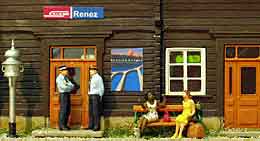
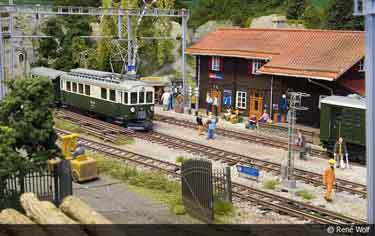
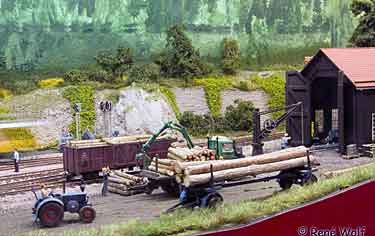
René Wolf, from The Netherlands, has modeled a meter-gauge line in Switzerland—specifically, a fictional station called Renez, a resort community on the RhB line in the Swiss Alps. Renez is a busy place for the railway, especially because of the tourist traffic. In warm weather, hikers and fishermen abound, while the cold brings skiers and other “Winter Athletes.”
The layout is HOm scale, measuring 160x45cm with two hidden extension tracks at each end. It’s an exhibition layout, as the photos show, and uses a picture frame (proscenium arch) with integral lighting. There are many more photos and additional information at René’s website and photo gallery pages. He’s also made a video of the line, which you can view by clicking on the black triangle below.
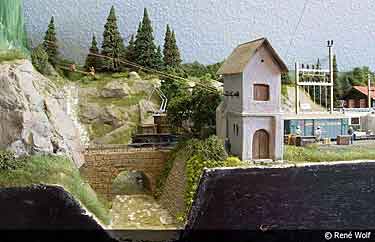
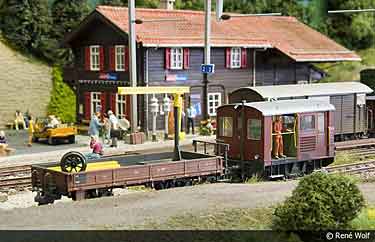
Hallo,
ich habe heute zum ersten mal die Seiten angeschaut. Die Layouts sind sehr schön und es gibt viele Tipps und Anregungen. Das macht Mut selbst zu bauen und vorzustellen.